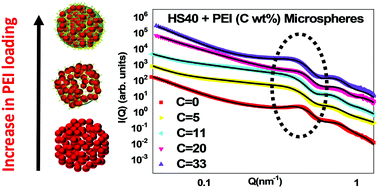Polyethylenimine assisted non-monotonic jamming of colloids during evaporation induced assembly and its implication on CO2 sorption characteristics†
Abstract
We report a detailed study of hierarchically organized silica–polyethylenimine (PEI) microspheres achieved through evaporation-induced assembly. Due to complex interactions between oppositely-charged silica nanoparticles and PEI, non-monotonic jamming of the colloidal particles is manifested. With an increase in the polymer concentration, the local volume fraction of the silica particles decreases from 0.68 to 0.43 and then increases to 0.55 with further increase. The unusual jamming behaviour of the silica colloids in the presence of PEI provides an avenue for immobilizing PEI without reducing the porosity and specific area in contrast to the conventional impregnation approach. The resultant composite microspheres show good thermal stability and CO2 sorption characteristics. For a 33 wt% PEI loading, the microspheres exhibit a significant CO2 capture capacity of 65 mg g−1 even at room temperature and it is increased to 90 mg g−1 at 75 °C. The variation in the CO2 capture capacity at 0 °C as a function of PEI loading also demonstrated the signature of non-monotonicity owing to the structural modification in the silica–PEI microspheres. The composite microspheres demonstrated fast adsorption kinetics reaching 70% of the total capture capacity in one minute during the CO2 capture. The CO2 cycling adsorption–desorption studies showed good regeneration capability up to 20 cycles.



 Please wait while we load your content...
Please wait while we load your content...